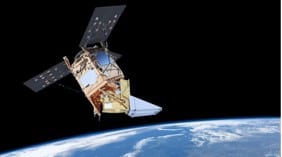 Greenhouse gases – a major international research priority
Greenhouse gases – a major international research priority
Greenhouse gases are accumulating in the atmosphere but our current understanding of their sources and sinks is poor. Robust, transparent evaluation of global greenhouse gas emissions is now recognised as a major international research priority.
Unprecedented data volumes require new statistical techniques
The Earth’s surface is far too large to measure its gas emissions directly. The Atmospheric Chemistry Research Group has therefore pioneered the use of statistical methods to indirectly infer spatio-temporal emissions based on a limited number of concentration measurements and atmospheric models.

The successful launch of the TROPOMI instrument on board the Sentinel 5 Precursor satellite in October 2017 will provide unprecedented data volumes (around 105 soundings per hour) on atmospheric methane in the atmosphere. The new measurements have the potential to provide us with a wealth of information to improve emission estimates but the currently used statistical techniques will become computationally prohibitive with such large data volumes.
Project goals
The project is a proof of concept application of an integrated nested Laplacian approximation (INLA) to infer greenhouse gas emissions, firstly to a synthetic dataset and then to the well-understood problem of estimating methane emissions in the UK.
This study paves the way for a much larger research proposal, being the first to use advanced spatio-temporal statistics to exploit the new abundance of Earth observation data for regional and global greenhouse gas emission estimation.
Policy makers, industry and scientists all have a role in tackling climate change
- Policy makers need to understand emissions at national scales so that they can enact appropriate regulation and ensure that protocols are being followed.
- Industry representatives need to know the impact that their activities have on the global climate.
- Scientists hope to improve their understanding of the global carbon cycle, which will allow for more accurate predictions of future climate change.
Leading to bigger things
The project was successful in demonstrating that we can use large data sets to infer methane emissions using INLA. This means that we will be able to take advantage of new large data volumes offered by the TROPOMI instrument.
The work also led to a result that improves existing top down estimates of regional greenhouse gas emissions using novel spatio-temporal statistics.
With the ability to handle these large data volumes, we aim to move up to a wider project estimating global methane emissions with the detail currently only possible on a regional scale.
Blog written by Luke Western, Research Associate, School of Chemistry.
Acknowledgements
Zhe Sha, Research Associate in Sea Level Research (Computational Statistics), School of Geographical Sciences.
This project was funded by the Jean Golding Institute Seed Corn Funding Scheme 2018. To find out about other projects supported by this scheme, take a look at the Jean Golding Institute Projects.

